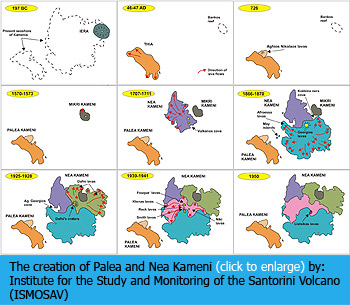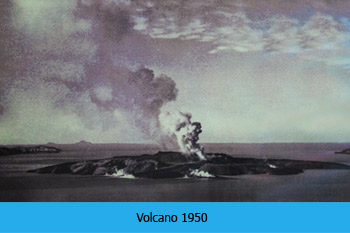Santorini Volcano:
Formation of Palea and Nea Kameni
In 197 BC, a new eruption created a small island named Iera and in 46 AD, the island of Thia emerged beside it. The volcano showed no more activity until 726 AD, when the new eruption produced material that united Iera and Thia and formed Palea Kameni. Its biggest part collapsed into the caldera later, as is suggested by the abrupt Schmidt's cut.
From 1570 to 1573, new explosions gave birth to another island, 4 km northeast of Palea Kameni. It was named Mikra Kameni.
In 21 May of 1707, a white island, from pumice and lava, emerged from the sea and kept on getting bigger and bigger. In 5 June, the same happened and another island, of black lava this time, appeared. In 12 September, they united and they formed Nea Kameni.
From 1866 to 1870, a series of successive explosions connected Nea and Mikra Kameni and brought to surface the two islets of May. Those two subsided later but can still be seen, as they are just one meter below water between Palea and Nea Kameni.
Nea Kameni continued its volcanic activity in the course of the 20th century. Flows of lava expanded notably the island (Georgios and Afroessa lavas in 1866, Liatsikas lavas in 1950) and created several domes (Dafni dome in 1925, Nautilus dome in 1928, Fouque, Ktenas, Smith A, Smith B, Reck and Niki domes from 1939-1941). In 1940, two explosions "unplugged" two large craters, 50 meters each.
|


|